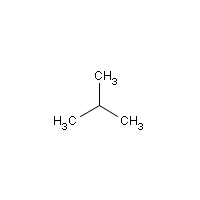Isobutane
Agent Name
Isobutane
CAS Number
75-28-5
Formula
C4-H10
Major Category
Solvents

Synonyms
1,1-Dimethylethane; 2-Methylpropane; Propane, 2-methyl-; R 600a; Trimethylmethane; [ChemIDplus]
Category
Aliphatics, Saturated (<C12)
Description
Colorless gas with a slight gasoline or natural gas odor; [HSDB]
Sources/Uses
Used as a fuel, a refrigerant, a propellant, and a gasoline additive; Used to calibrate instruments and to make other organic chemicals; [CHEMINFO] Used as an aerosol propellant and fuel source; [ACGIH]
Comments
In mice causes CNS depression at 15% for 60 minutes or 23% for 26 minutes; In dogs causes anesthesia at 45% for10 minutes. [HSDB] In rats, the LC50 (15 minutes) was 57%, "although the lack of oxygen likely contributed to the deaths of these animals." TLV Basis is CNS impairment; Volunteers exposed to 500 ppm 8 hours/day, 5 days/week for 2 weeks had no significant adverse effects; [ACGIH: Butane, isomers] Isobutane is in the list of "Some volatile substances which may be abused by inhalation" published on the web site of the U.N. International Drug Control Programme, indicating its potential to cause narcosis in workers. [Reference #1] See "n-Butane" and "Cyclobutane."
Reference Link #1
Biomedical References
Exposure Assessment
Skin Designation (ACGIH)
Insufficient data
STEL (ACGIH)
1000 ppm
MAK
1000 ppm (for Butane, isomers)
Vapor Pressure
2610 mm Hg
Lethal Concentration
LC50 (rat) = 570,000 ppm/15 min
Explanatory Notes
"Explosion Hazard." [TLVs and BEIs] VP from ChemIDplus;
NFPA
burn readily
Adverse Effects
Neurotoxin
Acute solvent syndrome
Other Poison
Simple Asphyxiant
Diseases, Processes, and Activities Linked to This Agent
Diseases
Occupational diseases associated with exposure to this agent: